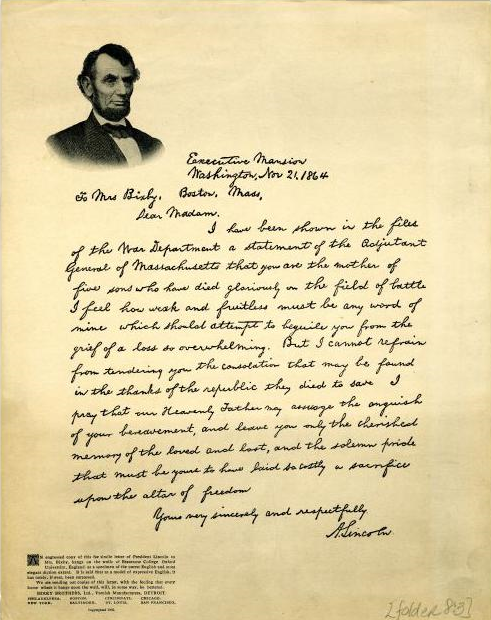Did you know? Legend says on Nov. 21, 1864 Lincoln wrote to a Civil War widow
- Details

At that time, it was common for copies of presidential messages to be published and sold as souvenirs, so it would make sense Lincoln’s letter was in the Boston Evening Transcript. However, some historians seem to think the letter was actually written by Lincoln’s secretary, John Hay. The mystery of the legitimacy of the letter grew when scholars discovered Mrs. Bixby actually only seemed to lose three sons during the Civil War, the other one was honorably discharged and the second was dishonorably thrown out of the Army. While the loss of three sons is still unimaginable, the letter claiming the loss of all five has thrown it into the unknown facts of history. Perhaps a report came in wrong and Lincoln truly believed she had lost five of her children or maybe during the grief surrounding the country at the time Lincoln wanted to offer up condolences to the nation and thought Mrs. Bixby’s story was the best to address, having his secretary help.
Whatever the truth behind the letter is, it has only grown in infamy in the modern day as it was quoted in the famous movie Saving Private Ryan by the character Gen. George C. Marshall who was played by Harve Presnell. The movie tells the story of Captain Miller, played by Tom Hanks, and his men as the go behind enemy lines to find Private Ryan. Ryan’s three brothers have been killed in combat. The soldiers set out hoping to save Ryan’s mother from the same fate as Mrs. Bixby. While the Lincoln letter’s origins are unclear, the words contained within it still inspire compassion for U.S. soldiers and their families to this day.
“It’s Bond, James Bond,” depicted in world’s largest corn maze in Illinois
- Details

The maze was shaken, not stirred, as it was created to also feature a Bond girl, a Monaco casino and an Aston Martin car driven by 007. The corn maze is distinguished as the world’s largest corn maze, it stretches 10 miles and spans over a 28-acre area. Those who came to visit the maze needed all the skills of a great spy to work their way through it, as the maze is actually created out of 4 smaller mazes, each one having its own dedicated in and out path. The maze was created using state of the art design and planting technology. Last year the Richardson Farm depicted the famous band “The Beatles” in their corn. Every year Illinoisans wait in anticipation to see what the farmers will create next, and hopes are high for another spectacular maze in 2023.
The corn maze was open September through October of this year, and the amazing design of James Bond through the decades drew a lot of media attention to the Illinois farm. As fall season comes to a close and the holiday season is upon us, the Richardson Farm is switching gears from corn to pine. The Richardson Christmas Tree Farm will be opening the day after thanksgiving, and those who enjoyed the spy-level maze can now enjoy getting a tree with their families for the holidays.
Those who wish to visit the farm can visit their website here.
Couple married in an Aldi grocery store in Illinois
- Details

The couple noted their love of Aldi, saying how their busy work schedules leave little time for romance, so their weekly Sunday morning Aldi grocery trips became a tradition where they always made time to spend together. Jessica and Michael won out of 500 other couples who applied to get married at an Aldi. They were the first couple ever to get married at one of their locations.
The wedding was officiated by one of the grocery store employees. After the ceremony, guests headed to the beer and wine section for the reception. Cocktail hour consisted of Aldi classics like chicken sliders, jumbo coconut shrimp and a charcuterie board that spanned an entire checkout lane. The wedding cake was a three-tiered carrot cake with a wedding cake topper featuring a shopping cart and fondant colors matching the Aldi logo.
In addition to winning the wedding ceremony, the couple also won free groceries for a year and a wedding registry including small kitchen appliances, bedding, towels and home goods. Aldi helped provide essentials for the couple starting out. Aldi is a purveyor of fresh produce, deli meet, milk, bread and love.
Multiple locations in Illinois have received Preservation Awards
- Details
 When thinking of visiting Chicago, the first thing that comes to mind might be the Sears Tower, the Bean or the Ferris Wheel at Navy Pier. These are all famous landmarks of the city. Landmarks are a staple of towns and cities, and are the most recognizable aspects of a town that can draw in tourists or fill residents with pride. Landmarks in any town deserve to be recognized and preserved, which is exactly what the Landmarks Illinois Richard H. Driehaus Foundation Preservation Awards accomplish. Multiple locations in Illinois have been chosen for the 2022 Awards.
When thinking of visiting Chicago, the first thing that comes to mind might be the Sears Tower, the Bean or the Ferris Wheel at Navy Pier. These are all famous landmarks of the city. Landmarks are a staple of towns and cities, and are the most recognizable aspects of a town that can draw in tourists or fill residents with pride. Landmarks in any town deserve to be recognized and preserved, which is exactly what the Landmarks Illinois Richard H. Driehaus Foundation Preservation Awards accomplish. Multiple locations in Illinois have been chosen for the 2022 Awards.
This year was the 29th annual anniversary of the awards program, which celebrates preservation efforts in Illinois. The winners are chosen by a jury of preservation professionals across all of Illinois, who select locations based off of the positive impact on their community, the way it inspires others to save places, and the degree to which it aligns with Landmarks Illinois’ mission. Landmarks Illinois was established in 1971 and is the state’s leading voice for historic preservation. They help communities all over the state save the important places in their lives through a wide range of programs, such as the Preservation Awards.
This year awards such as the Award for Advocacy, the Award for Restoration and the Award for Rehabilitation were given out, among others. The Award for Advocacy was bestowed upon Hotel Belleville in Belleville. The 91-year-old former hotel has been rehabilitated into an affordable housing development called “Lofts on the Square.” The Award for Restoration was given to the Chicago Cultural Center Grand Army of the Republic Rooms. This building is Chicago’s main public library, and has undergone $15 million in restoration to preserve its original features. The Award for Rehabilitation was granted to Crown Brew Coffee Co. in Marion. The coffee shop opened in October 2020 in a 120-year-old building. The coffee shop was rehabilitated by its owners, and was the first business to open in a city-led downtown revitalization effort, proving what is possible when local governments and business owners come together for their town’s economic development.
To see the full list of 2022 recipients of the Richard H. Driehaus Foundation Preservation Awards you can visit here.



